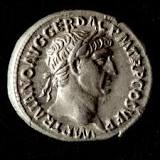
Denarius bearing the image of Tiberius Caesar
A denarius was a coin used in the Roman Empire. It was worth a laborer's daily wage. Older English versions use "penny", "pence", and "pennyworth" to translate this coin. Newer version transliterate the Greek or use terms denoting a day's wage.
History
The smallest coin of the Roman coinage system after Augustus implemented reform was the copper as. The denarius was a silver coin originally representing a value of ten asses (not the animal!). By the first century AD, under these reforms, the value of a denarius had been increased to 16 asses. An as officially weighed about 3.9 grams, with a value in 2015 of about two cents ($ 0.02). This would, in absolute terms, give the denarius a value of about thirty-two cents ($ 0.32).
The Day's Wage[1]
To teach a lesson about just who might be a citizen of the "kingdom of heaven," Jesus told the parable of laborers hired to harvest grapes. The owner of the vineyard went early in the morning to the local labor pool: able bodied men looking for work in the town square. He acquired their services for a denarius ('penny'). Historians verify the veracity of this wage in the first century AD. The landowner had need of more workers throughout the day, finally even hiring men to work for just one hour.
When it came time to pay the crew, the landowner paid the last first: a full denarius each! When the men that had agreed to work for a denarius screamed "foul." The landowner reminded them of their agreement, and sent them on their way with a denarius. He further reminded them that it was up to him to decide what was 'fair.' The point was that the choice of who comes into the vineyard was the owners alone. The value of each of those he chose was equal in his sight.
Caesar's Image
Authorized coinage demonstrates that the authority who makes the coin has legitimate claim upon that coinage. For this reason, there were "bankers" at the temple to convert Greek and Roman coins into coins minted under the authority of the priesthood. These money changers were notorious for the rates they charged.[2]
When Jesus was faced with the dilemma concerning paying taxes to the government of Rome, he asked for a coin.[3] The coin brought to Jesus, for he apparently did not carry money, was a denarius. The coin was the authorized silver coin equal to the value of the drachma of the Greeks. The standard temple shekel was worth four denaria.
Jesus pointed out that there was an image stamped on the coin. He asked his challengers whose image was on the coin. It was that of the emperor, Tiberius Caesar. This answered the question: pay your taxes that are due to the authority behind the coinage. That which belongs to the government is to be used to pay the government.[4]
